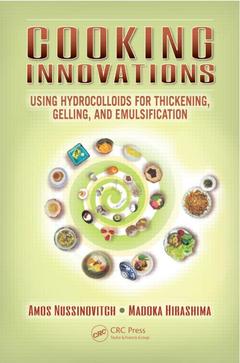Description
Cooking Innovations
Using Hydrocolloids for Thickening, Gelling, and Emulsification
Authors: Nussinovitch Amos, Hirashima Madoka
Language: English
Subject for Cooking Innovations:
Keywords
White Sugar; Xanthan Gum; Hydrocolloids; FRU; Water-soluble polymers; Gellan Gum; Viscosity formers; Km; Thickeners; Konjac Mannan; Gelling agents; Moisture Content; Emulsifiers; Gel Strength; Stabilizers; Xanthan Gum Powder; Texturizers; Tara Gum; Guar Gum; LBG; BLE; Tapioca Starch; Konjac Flour; Gellan Gum Solution; Ice Water Bath; Garlic Powder; Can; Gellan Gum Gels; Fenugreek Gum; Gum Arabic; Potato Starch; Sweet Potato; Red Bean Paste
123.78 €
In Print (Delivery period: 15 days).
Add to cartSupport: Print on demand
Description
/li>Contents
/li>Biography
/li>
While hydrocolloids have been used for centuries, it took molecular gastronomy to bring them to the forefront of modern cuisine. They are among the most commonly used ingredients in the food industry, functioning as thickeners, gelling agents, texturizers, stabilizers, and emulsifiers. They also have applications in the areas of edible coatings and flavor release. Although there are many books describing hydrocolloids and their industrial uses, Cooking Innovations: Using Hydrocolloids for Thickening, Gelling, and Emulsification is the first scientific book devoted to the unique applications of hydrocolloids in the kitchen, covering both past uses and future innovations.
Each chapter addresses a particular hydrocolloid, protein hydrocolloid, or protein?polysaccharide complex. Starting with a brief description of the chemical and physical nature of the hydrocolloid, its manufacture, and its biological/toxicological properties, the emphasis is on practical information for both the professional chef and amateur cook. Each chapter includes recipes demonstrating the particular hydrocolloid?s unique abilities in cooking. Several formulations were chosen specifically for food technologists, who will be able to manipulate them for large-scale use or as a starting point for novel industrial formulations.
The book covers the most commonly used hydrocolloids, namely, agar?agar, alginates, carrageenan and furcellaran, cellulose derivatives, curdlan, egg proteins, galactomannans, gelatin, gellan gum, gum arabic, konjac mannan, pectin, starch, and xanthan gum. It also discusses combining multiple hydrocolloids to obtain novel characteristics. This volume serves to inspire cooking students and introduce food technologists to the many uses of hydrocolloids. It is written so that chefs, food engineers, food science students, and other professionals will be able to cull ideas from the recipes and gain an understanding of the capabilities of each hydrocolloid.
Hydrocolloids—Where, Why, and When? Agar–Agar. Alginates. Carrageenan and Furcellaran. Cellulose Derivatives. Curdlan. Egg Proteins. Galactomannans. Gelatin. Gellan Gum. Gum Arabic. Konjac Mannan. Pectin. Starch. Xanthan Gum. The Use of Multiple Hydrocolloids in Recipes. Glossary. Alphabetical List of Hydrocolloid Manufacturers and Suppliers. Index.
Professor Amos Nussinovitch was born in Kibbutz Megiddo, Israel. He studied chemistry at the University of Tel Aviv, and food engineering and biotechnology at the Technion – Israel Institute of Technology. He has worked as a food engineer at several companies and has been involved in a number of R&D projects in both the United States and Israel, focusing on the mechanical properties of liquids, semisolids, solids, and powders.
He is currently in the Biochemistry and Food Science Department of the Robert H. Smith Faculty of Agriculture, Food and Environment of the Hebrew University of Jerusalem, Israel, where he leads a large group of researchers working on theoretical and practical aspects of hydrocolloids. Prof. Nussinovitch is the sole author of five books, the author or coauthor of numerous papers on hydrocolloids and on the physical properties of foods, and an inventor on many related patent applications.
Madoka Hirashima, Ph.D., was born in Kyoto, Japan. She studied the rheological properties of curdlan and cornstarch at the Graduate School of Human Life Science, Osaka City University. Dr. Hirashima worked at a food company as a new food developer, and then as a lecturer at several colleges. She is currently in Home Economics Education at the Faculty of Education, Mie University, where she teaches cooking as well as cooking science. She continues to study the rheological properties of polysaccharides, with a focus on the textures of starch and konjac products.




